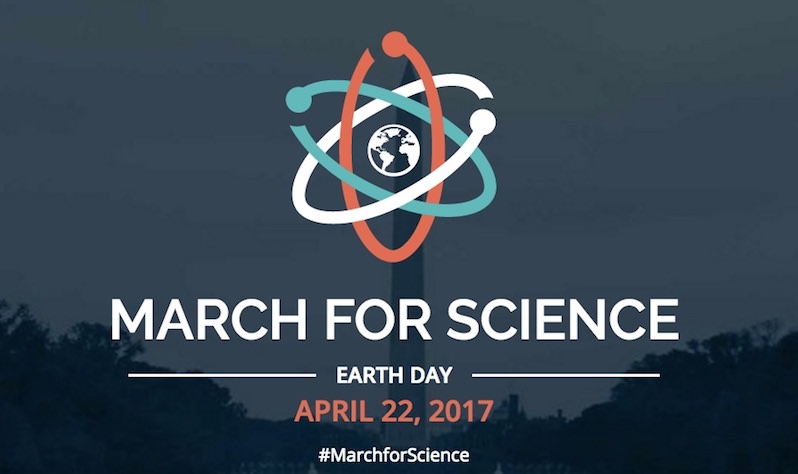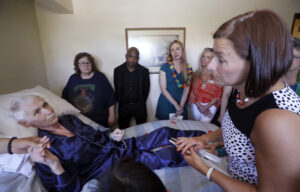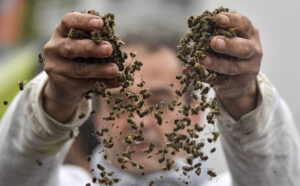Why I Will March for Science on Saturday
As the White House and Congress take their budget knives to science funding, most of the leading U.S. scientific institutions are urging their members to hit the streets. Throughout the country, scientists and supporters will demonstrate on Earth Day. (March for Science)
Throughout the country, scientists and supporters will demonstrate on Earth Day. (March for Science)
By Laurie Garrett / Foreign PolicyEditor’s note: Watch Truthdig correspondents’ on-the-ground coverage of Saturday’s March for Science events in Washington, D.C., and Los Angeles.
On Saturday, scientists and their supporters will leave the sanitized comfort of their labs and academic environs to march in Washington, D.C., and more than 400 other cities and 100 countries around the world.
It all started with a tweeted picture of a child holding a pro-science sign at the Jan. 22 March for Women, followed by health educator Caroline Weinberg’s tweet, “Hell hath no fury like a scientist silenced,” and swiftly grew into the largest protest since the women’s event.
It’s a very big, twofold gamble on their part. First, reckoning that the typically apolitical and highly government-dependent scientific community will break with their tradition of political silence in large-enough numbers to create a serious presence, rather than a pathetic disappointment. And second, wagering that the vision of tens of thousands of angry nerds and geeks will have the desired positive impact on policymakers and the public at large. That’s a tough one. While “The Big Bang Theory” may have enjoyed top TV ratings for the past decade, average Americans are leery of real-life Leonards and Sheldons and their discoveries.
Most of the leading scientific institutions in the United States are backing both propositions and urging their members to hit the streets on Saturday. From the American Association for the Advancement of Sciences (AAAS, the publisher of Science) to the editorial board of Nature and the New York Academy of Sciences and its counterparts across the country, the admonishment is clear: Get out and march!
The 157,000-strong American Chemical Society has asked its members to conduct marches that will constitute “a nonpartisan celebration of science,” and a long list of professional societies echoed that sentiment. The Bulletin of Atomic Scientists is backing the march, saying, “The truth needs an advocate.”
The London-based Nature Cell Biology, a journal noted for controversies regarding the relative contributions of various cell receptors to triggered enzyme activity, told its readers that it’s time for scientists to “become political,” citing the potentially devastating double impact of Brexit’s limits on freedom of movement affecting immigrations for scientists and President Donald Trump’s anti-science stances.
A similarly staid American publication, The Chronicle of Higher Education, called upon universities to back the protest as a form of mass education, telling the world about the wonders of science.
“Scientists have to be reminded that the response to a challenge to science is not to retreat to the microscope, to the laboratory, to the ivory tower,” Rush Holt, CEO of the AAAS, said recently. “This requires vigorous defense.”
The annual February meeting of the AAAS found session after session overcome by anger and angst as researchers and science educators tried to comprehend how America in 2017 had seemingly become as anti-science as Trofim Lysenko’s Soviet supporters in the Kremlin in the 1930s to 1950s. Those Soviets blindly followed the idiotic agronomist Lysenko’s pseudo-biological claims to purge and execute thousands of scientists across the USSR for the sin of believing in Charles Darwin, evolution, Gregor Mendel, and genetics.
Some protesting scientists might argue that sentiments today are even as inane as the Vatican trial of Galileo Galilei that on June 22, 1633, denounced the great astronomer for insisting that Earth orbits the sun, decreeing, “The proposition that the Sun is the center of the world and does not move from its place is absurd and false philosophically and formally heretical, because it is expressly contrary to Holy Scripture. The proposition that the Earth is not the center of the world and immovable but that it moves, and also with a diurnal motion, is equally absurd and false philosophically and theologically considered at least erroneous in faith.”
The deleterious effects were generational. Soviet leaders Josef Stalin and Nikita Khrushchev imposed Lysenko’s crackpot theories for nearly four decades, sending to gulag slaughterhouses two generations of biologists. In 1997, I found physicians and scientists all over the former USSR unable to accept the most basic concepts of evolution and genetics, even allowing patients to die of hospital-acquired infections rather than concede that bacteria evolve under the natural selection pressure of inappropriate antibiotic use, making it impossible to treat infected post-op surgical patients. Similarly, the Vatican won in 1633, forcing the 70-year-old, nearly blind Galileo to recant his telescope observations of solar activity and planetary movement. Thankfully, science was the victor in the long run.Yes, Earth is round and it orbits the sun.
Yes, your feet stay on the ground unless you use a lot of energy to leap, because of gravity.
Yes, the lettuce on your salad plate came from plants that grew in soil by converting carbon dioxide and sunlight into their roots, stalks, and leaves, expiring oxygen. It’s called photosynthesis, a process the planet’s first bacterial life forms employed, drifting on the surface of the seas some 3.5 billion years ago, creating the oxygen-rich atmosphere you are now breathing.
Yes, creatures evolve under stress and genetic selection pressure, and that rate of evolution generally depends on the life form’s reproductive rate. Those that reproduce, like viruses, over a few minutes’ time may genetically evolve in a matter of days; those that reproduce every 20 or 30 years (such as Homo sapiens) may take hundreds of centuries to evolve in significant ways.
There will be many issues driving scientists to march on Saturday, from their pocketbooks to the sheer joy of solving nature’s puzzles unhindered. Having taken my undergraduate training in biology at the University of California, Santa Cruz, done graduate work in immunology at the University of California, Berkeley, and Stanford University, and postgraduate study at the Harvard School of Public Health, I am steeped in the firmament of the hypothesis-driven, reductionist view of life and its trillions of curiosities. But when I march it won’t be the scientific method that drives me, but a few key characters and episodes in my life.
I will march thinking of a man who sat next to me some 30 years ago on a domestic flight, reading the latest edition of the American Spectator, published by the John Birch Society. When I told the businessman that I made a living writing about science, he proclaimed the entire endeavor of research an illegitimate recipient of taxpayers’ money, insisting that the only good science was done in service of corporate earnings. I asked, “But haven’t you ever looked at a butterfly and wondered why it was brightly colored, or wandered through an orchard of blooming cherry blossoms and gasped at their glory, asking why and how such spectacular pinkness occurred?” No, the man said emphatically, adding that the questions were “stupid.” And so I will march thinking of how astonished I was at the very idea of a human without a sense of wonder, recalling the eerie omen of bottom-line thinking about the utility of science that lay inherent in his attitude – one it seems our president is sympathetic to.
I wish when I had that unnerving conversation 30 years ago I had more facts on hand about the profitability of taxpayer-funded science. One U.S. agency alone – the National Institutes of Health (NIH) – issued 365,380 grants to scientists from 1980 to 2007, 9 percent of which resulted in patented discoveries and an additional 31 percent linked to patent applications. Among grants given for disease research, an astounding 35 percent led to patents. Not every patent translates into millions of dollars’ worth of profits, but a 35 percent patent rate in the research-and-development section of a technology or pharmaceutical corporation would be considered spectacular.
I will march thinking of a Soviet-trained immunologist I met in Irkutsk in the 1990s who insisted his people would never recover from the Cold War and build a decent democracy because Russians were, he said, “genetically inferior remnants” of Slavic humanity – the best having been systematically exterminated by tsarist pogroms of Jews and the Stalinist genocide of intellectuals and dissidents. That tsarist and Soviet slaughter had transpired was undeniable, but such baseless claims of genetic inferiority, coming from a powerful scientist, were shocking.
I will march recalling getting off a train in Surat, India, in 1994 amid an outbreak of Yersinia pestis, the bacterium that causes plague, to discover that the elite classes had abandoned the diamond-cutting city, along with all but five physicians, leaving pharmacies and clinics shuttered, with just one public hospital carrying the full outbreak burden. The poorer populace was abandoned to their fates out of mass terror over a microbe easily treated and prophylactically blocked with the world’s cheapest, mildest antibiotics.
From the first recognition of AIDS in 1981, I followed the expanding HIV pandemic all over the world, watching even more egregious nonscientific thinking and bigotry drive governments on every continent to institute policies against the human sufferers of the disease, rather than fund serious public health measures and basic research attacking the virus itself. When I march I’ll be thinking of the 18 million people who are kept alive each day by science and its discovery of effective anti-HIV drugs.
I’ll also be marching with heroes in my heart. Jonas Salk, a scientist who discovered the first polio vaccine and a generous and delightful human being. I’ll also be thinking of another polio-fighting hero I had the honor of meeting recently – Pakistani rock star Salman Ahmad, who inspires parents to vaccinate their children despite Taliban assassinations of more than 150 immunization workers.
I’ll be thinking of Dave Keeling, who in 1953 had the crazy idea that carbon dioxide levels were rising all over the planet due to the surge in automobile use and pushed for funds to create a remote, high-altitude measuring station to capture CO2. In March 1958, Keeling launched his measuring station atop Hawaii’s Mauna Loa volcano, recording a CO2 concentration of 313 parts per million (ppm). He tested and logged what is now the Keeling Curve, and the monitoring continues all over the world. On April 15, Mauna Loa CO2 topped 409 ppm. When plotted over an 800,000-year span, the past 70 years clearly represent the most dramatic surge in carbon dioxide in planetary history.No matter how severely governments, including the Trump administration and GOP-led Congress, slash science budgets and deny research findings, empirical reality eventually wins. History proves that hypothesis.
Lysenko claimed there was no “evolution” in a Darwinian or Mendelian sense, but “adaptation.” He allegedly proved this by growing a plant in a refrigerated environment, claiming that after a few growth cycles the plant adapted to the snowlike conditions and thrived. With the same ridiculous logic, the Ukrainian-born nutcase assured Stalin that Siberia’s vast tundra could support wheat production; as the grain plants adapt to the cold climes, they would provide rich harvests for the proletariat. Instead, of course, massive famines greeted the Soviets, so severe that incidents of wholesale starvation and cannibalism were recorded throughout the mid-20th century.
Thanks to Peter Pringle’s terrific The Murder of Nikolai Vavilov, I will be thinking of the Russian geneticist who dared to denounce Lysenko as “the biggest fraud in biology” and paid for doing so with his life, starving to death in the still-notoriously brutal Saratov prison in 1943.
Our world is awash with dangerously stupid ideas, in rejection of evidence and serious science. Crackpots reign on the internet, of course. But worse, the very concept of expertise is under attack, Tom Nichols argues, risking that “eventually both democracy and expertise will be fatally corrupted, because neither democratic leaders nor their expert advisers want to tangle with an ignorant electorate.”
Ignorance is bad, but willful censorship of science is far more sinister. In his flurry of executive orders in January, Trump issued one forbidding researchers at the Environmental Protection Agency and the Department of Agriculture to communicate their findings and evidence of climate change to the public. Over subsequent weeks, government websites for agencies as diverse as the EPA and NASA have been cleansed of data and news about pollution, climate change, and a variety of other scientific issues.
Many marchers will have been galvanized by EPA Secretary Scott Pruitt’s comments. Asked how significant human factors, such as burning fossil fuels, were as causes of climate change, Pruitt opined, “I think that measuring with precision human activity on the climate is something very challenging to do, and there’s tremendous disagreement about the degree of impact, so no, I would not agree that it’s a primary contributor to the global warming that we see,” prompting an immediate flurry of protests from top climate scientists.
For some protesters on Saturday it will be the White House’s immigration policies that brought them to the streets, limiting the free movement of graduate students, scientists, and physicians into the United States.
Some will raise their voices in anger that Trump is the first president since World War II to deliberately forgo appointing a White House science advisor heading the Office of Science and Technology Policy.
Surely some of the marchers will share my outrage over the rising anti-vaccine movement in Europe, Australia, Canada, and the United States, emboldened by Trump’s appointment of vaccine skeptic Robert F. Kennedy Jr. to head a panel into the safety versus “uselessness” of child immunization. A few might have a fire in their bellies over the Republican-led congressional eight-month blockade of funding for Zika research and development, forcing both the NIH and the Centers for Disease Control and Prevention (CDC) to rob other disease programs in order to find resources to fight the new virus.
I have been disappointed by the decisions of prominent, financially comfortable senior scientists who doubt the dignity and utility of protest and decline to march. Perhaps comforted by their multiyear NIH funding or grants from private philanthropies, such as the Howard Hughes Medical Institute and the Bill & Melinda Gates Foundation, these senior lab bosses can’t see it in their interests to rock boats and voice protest. But their junior scientists – undergraduates, graduate students, postdocs, and untenured faculty – give voice to very different sentiments. Even before Trump called for a $6 billion, 18 percent slash of the NIH budget – the single-largest reduction in biomedical science since the NIH’s creation in 1948 – the future was grim for young researchers.
In recent years, on average, a quarter of NIH research grants have met with approval, but only 17 percent have received funds. Funding rates were even lower for African-American and Latino applicants. And for all categories of race and gender, the worst odds of gaining funding were for scientists under 45 years old. The average age for the first grant as an independent researcher rose from 38 in 1980 to 45 in 2013, and less than 3 percent of scientists under 36 were able to obtain principal investigator grants to run their own labs. More private and government money underwrites research run by scientists over 65 than by those under 40.
As the White House and Congress take their budget knives to government science funding at the CDC, NIH, EPA, and other agencies, we risk destroying the future of American scientific discovery, letting the laboratories of today gray into tomorrow, locking talented immigrants out of the country and denying support to two generations of junior researchers. If the odds of a 21st-century Albert Einstein or Marie Curie obtaining funding for his or her own laboratory before reaching the age of 36 were only 3 percent before Trump, what will they be by this time next year – zero?
So as a graying baby boomer, I shall march for the millennials who delight in analyzing DNA sequences, dream of studying cosmic rays from the space station, spend their summers measuring melting Arctic icebergs, test batteries of drugs in search of one that can pulverize HIV, climb inside dark caves to figure out what is killing the world’s bats, make antibodies that attack cancer cells, and study communication among elephants. On Saturday, I march for science, for Jonas Salk, Salman Ahmad, Dave Keeling, Nikolai Vavilov, and for the entire generation of millennial scientists.
Your support matters…Independent journalism is under threat and overshadowed by heavily funded mainstream media.
You can help level the playing field. Become a member.
Your tax-deductible contribution keeps us digging beneath the headlines to give you thought-provoking, investigative reporting and analysis that unearths what's really happening- without compromise.
Give today to support our courageous, independent journalists.








You need to be a supporter to comment.
There are currently no responses to this article.
Be the first to respond.